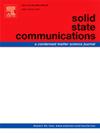Exploring Penta-BCN nanosheet as a promising anode material for rechargeable Mg-ion batteries: A computational study
IF 2.1
4区 物理与天体物理
Q3 PHYSICS, CONDENSED MATTER
引用次数: 0
Abstract
The substantial increase in demand of clean and sustainable energies compels the scientific community to design new promising anode materials with fast charge/discharge rates. The current study presents pent-BCN as 2D anode material for Mg ions batteries through first principles simulations. The adsorption energy is negative up to the saturation limit of Mg ions onto penta-BCN, which confirms their binding stability. At saturation level, a maximum 22 (40.74 %) Mg ions were loaded on the most stable site with a specific capacity of 1778.79 m Ah/g. The diffusion barrier for loaded Mg ions onto penta-BCN is much smaller (0.28 and 0. 39 eV), which reveal the fast migration of Mg ions on penta-BCN monolayer. AIMD analysis indicates that fully loaded Mg ions penta-BCN is thermodynamically stable at 300K. The adsorption of Mg ions onto penta-BCN makes it metallic. The OCV decreases as loaded Mg ions concentration increases onto penta-BCN. At saturation level (40.74 %), penta-BCN exhibits 0.17 OCV, which reflects that the penta-BCN can further accommodate Mg ions. Hence, 2D penta-BCN can be an efficient anode material for Mg ions batteries. Furthermore, this study will also help experimentalists to explore new materials that can show high specific capacity and fast migration rate of adsorbed ions.

探索5 - bcn纳米片作为可充电镁离子电池负极材料的前景:计算研究
清洁和可持续能源需求的大幅增长迫使科学界设计具有快速充放电速率的新型有前途的阳极材料。本研究通过第一性原理模拟,提出了将bcn作为镁离子电池的二维负极材料。在5 - bcn上,Mg离子的吸附能为负,达到饱和极限,证实了其结合稳定性。在饱和状态下,最稳定位点最多可装载22个Mg离子(40.74%),比容量为1778.79 m Ah/g。负载Mg离子在5 - bcn上的扩散势垒要小得多(0.28和0。39 eV),揭示了Mg离子在5 - bcn单层上的快速迁移。AIMD分析表明,满载Mg离子5 - bcn在300K时热力学稳定。镁离子吸附在五bcn上使其具有金属性。随着负载Mg离子浓度的增加,OCV降低。在饱和水平(40.74%)下,5 - bcn的OCV值为0.17,说明5 - bcn可以进一步容纳Mg离子。因此,二维五元bcn可以作为镁离子电池的高效负极材料。此外,本研究还将有助于实验工作者探索具有高比容量和吸附离子快速迁移速率的新材料。
本文章由计算机程序翻译,如有差异,请以英文原文为准。
求助全文
约1分钟内获得全文
求助全文
来源期刊

Solid State Communications
物理-物理:凝聚态物理
CiteScore
3.40
自引率
4.80%
发文量
287
审稿时长
51 days
期刊介绍:
Solid State Communications is an international medium for the publication of short communications and original research articles on significant developments in condensed matter science, giving scientists immediate access to important, recently completed work. The journal publishes original experimental and theoretical research on the physical and chemical properties of solids and other condensed systems and also on their preparation. The submission of manuscripts reporting research on the basic physics of materials science and devices, as well as of state-of-the-art microstructures and nanostructures, is encouraged.
A coherent quantitative treatment emphasizing new physics is expected rather than a simple accumulation of experimental data. Consistent with these aims, the short communications should be kept concise and short, usually not longer than six printed pages. The number of figures and tables should also be kept to a minimum. Solid State Communications now also welcomes original research articles without length restrictions.
The Fast-Track section of Solid State Communications is the venue for very rapid publication of short communications on significant developments in condensed matter science. The goal is to offer the broad condensed matter community quick and immediate access to publish recently completed papers in research areas that are rapidly evolving and in which there are developments with great potential impact.
 求助内容:
求助内容: 应助结果提醒方式:
应助结果提醒方式:


